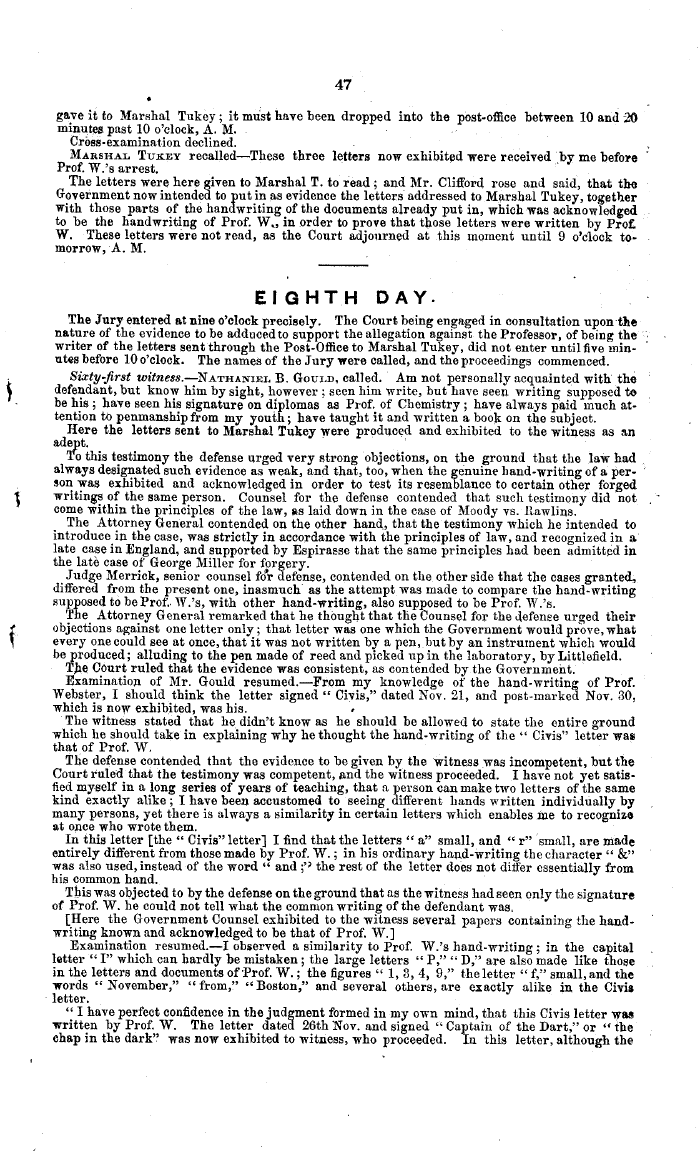|
47
gave it to Marshal Tukey ; it must have been dropped into the post-office
between 10 and 20
minutes past 10 o'clock, A. M.
Cross-examination declined.
MARSHAL TUKEY recalled-These three letters now exhibited were received ;by
me before
Prof. W.'s arrest.
The letters were here given to Marshal T. to read; and Mr. Cliford rose and
said, that the
Government now intended to put in as evidence the letters addressed to
Marshal Tukey, together
with those parts of the handwriting of the documents already put in, which
was acknowledged
to be the handwriting of Prof. W„ in order to prove that those letters were
written by ProE
W. These letters were not read, as the Court adjourned at this moment until
9 o'clock to-
morrow, A. M.
EIGHTH DAY.
The Jury entered at nine o'clock precisely. The Court being engaged in
consultation upon- the
nature of the evidence to be addnced to support the allegation against the
Professor, of being the
writer of the letters sent through the Post-Office to Marshal Tukey, did
not enter until five min-
utes before 10 o'clock. The names of the Jury were called, and the
proceedings commenced.
Sixty-first witness.-NATHANIEL B. GovLD, called. Am not personally
acquainted with the
defendant, but know him by sight, however; seen him write, but have seen
writing supposed to
be his; have seen his signature on diplomas as Prof. of Chemistry; have
always paid much at-
tention to penmanship from my youth; have taught it and written a book on
the subject.
Here the letters sent to Marshal Tukey were produced and exhibited to the
witness as an
ads t.
this testimony the defense urged very strong objections, on the ground that
the law had
always designated such evidence as weak, and that, too, when the genuine
band-writing of a per-
son was exhibited and acknowledged in order to test its resemblance to
certain other forged
writings of the same person. Counsel for the defense contended that such
testimony did not
come within the principles of the law, as laid down in the case of Moody
vs. Rawlins.
The Attorney General contended on the other hand,, that the testimony which
he intended to
introduce in the case, was strictly in accordance with the principles of
law, and recognized in a
late case in England, and supported by Espirasse that the same principles
had been admittt;d in
the late case of George Miller for forgery.
Judge Merrick, senior counsel for defense, contended on the other side that
the cases granted,
differed from the present one, inasmuch as the attempt was made to compare
the band-writing
supposed to be Prof.. W.'s, with other hand-writing also supposed to be
Prof. W.'s.
The Attorney General remarked that he thought that the Counsel for the
defense urged their
objections against one letter only; that letter was one which the
Government would prove, what
every one could see at once, that it was not written by a pen, but by an
instrument which would
be produced; alluding to the pen made of reed and picked up in the
laboratory, by Littlefield.
The Court ruled that the evidence was consistent, as contended by the
Government.
Examination of Mr. Gould resumed.-From my knowledge of the hand-writing of
Prof.
Webster, I should think the letter signed °1 Civis," dated Nov. 21, and
post-marked Nov. 30,
which is now exhibited, was his.
The witness stated that he, didn't know as he ~should be allowed to state
the entire ground
which he should take in explaning why he thought the hand-writing of the "
Civis" letter wag
that of Prof. W.
The defense contended that the evidence to be given by the witness was
incompetent, but the
Court ruled that the testimony was competent, and the witness proceeded. I
have not yet satis-
fied myself in a long series of years of teaching, that a person can make
two letters of the same
kind exactly alike; I have been accustomed to seeing different hands
written individually by
many persons, yet there is always a similarity in certain letters which
enables me to recognize
at once who wrote them.
In this letter [the " Civis" letter] I find that the letters °° a" small,
and '° r" small, are made
entirely different from those made by Prof. W.; in his ordinary
hand-writing the character " &"
was also used, instead of the word '1 and ;'~ the rest of the letter does
not differ essentially from
his common hand.
This was objected to by the defense on the ground that as the witness had
seen only the signature
of Prof. W. be could not tell what the common writing of the defendant was.
[Here the Government Counsel exhibited to the witness several papers
containing the hand-
writing known and acknowledged to be that of Prof. W. ]
Examination resumed.-I observed a similarity to Prof. W.'s band-writing; in
the capital
letter `° I" which can hardly be mistaken; the large letters " P," " D,"
axe also made like those
in the letters and documents of Prof. W.; the figures " 1, 3, 4, 9," the
letter " f," small, and the
words " November," °° from," 1° Boston," and several others, are exactly
alike in the Civis
letter.
`° I have perfect confidence in the judgment formed in my own mind, that
this Civis letter was
written by Prof. W. The letter date 26th Nov. and signed " Captain of the
Dart," or " the
chap in the dark" was now exhibited to witness, who proceeded. In this
letter, although the
|

